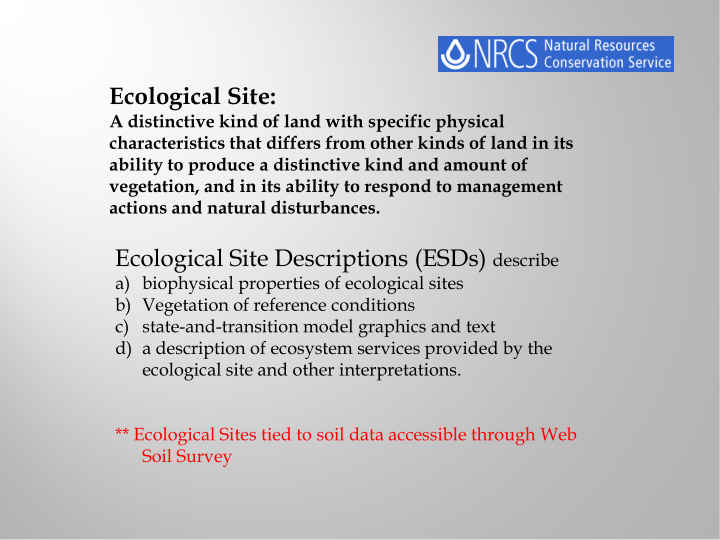



Ecological Site: A distinctive kind of land with specific physical characteristics that differs from other kinds of land in its ability to produce a distinctive kind and amount of vegetation, and in its ability to respond to management actions and natural disturbances. Ecological Site Descriptions (ESDs) describe a) biophysical properties of ecological sites b) Vegetation of reference conditions c) state-and-transition model graphics and text d) a description of ecosystem services provided by the ecological site and other interpretations. ** Ecological Sites tied to soil data accessible through Web Soil Survey
Define Part 1: Ecological Site Development: Approach Area of interest What are the reference Figure out conditions for different parts of the landscape? What ecological Reference processes are necessary to Conditions maintain the reference condition? Background research/ Reconnaissance Develop Initial Ecological Existing Data, Site Concepts: Geophysical, plant Literature, community Expert input Test Ecological Site Collected Data Concepts Reject Accept Ecological Site Description
Ecological Site Concepts based on: The MLRA-level “model” Soil Properties (fertility, texture, profile, Loamy soil(active piedmont) drainage) Susceptible to water erosion and Soil map units grass loss: vulnerable/restorable Landscape position / topography Climate Clayey soil (basin Vegetation: Reference sites floor)Receives water and sediment: low risk Gravelly soil(shallow, relict piedmont) Surface soil water limited, high risk for grass loss and erosion Sandy soil(relict basin floor) Erodible surface soils once grasses removed
Part 2: Ecological Site Description and Management Interpretations 1) Development of State and Transition Model 2) Identify Indicators of Reference conditions, states, and treshholds 3) Identify and describe management activities that affect phases and states T1 Shrub invasion Phase: D Phase: E Reference: A R1 STATE 2: Savanna Phase: B Fire, Shrub Phase C control STATE 1: Grassland State F STATE 3: Shrubland
Part 1: Example of Development of Ecological Site Concepts: Pine Uplands of the Lower Atlantic Coast Flatwoods • Using existing vegetation data as Reference Sites as a start • Create distinguishable MLRA site concepts 153A • Correlate those to soil map units (one-many)
Uplands Example of Development of Ecological Site P9 P99 Concepts: P15 P56 P42 P37 P32 P44 P34 P39 P43 P41 P45 P71 P16 P33 P10 P48 P35 P36 P7 P62 P50 P58 P59 P47 P8 P38 P21 P79 P53 P20 P97 P3 P46 P78 P14 P52 Reference site data for MLRA 153A P17 P54 P98 P85 P55 P49 P51 P65 P2 P25 P91 P6 P4 P24 P19 P72 P30 P96 P31 P83 P26 P60 P18 P22 P90 P64 P12 P94 P67 P66 P89 P61 P27 P13 P28 P70 Defining Ecological Site concepts from data (cluster and P68 P73 P1 P29 P5 indicator species analysis) P84 P88 P23 P77 P74 In this case, upland pineland communities only P75 P69 P92 P95 P80 P93 P86 P87 P81 P82 Pinus palustris-turkey(bluejack) oak Sandhills Pinus palustris-saw palmetto- Curtis dropseed flatwoods Pinus palustris-mixed forb-bluestem flatwoods
Develop Ecological Site concept Indicator plant species for MLRA pine upland reference sites Bluejack Oak ( Q. incana ) Turkey Oak ( Q. laevis ) Pinus palustris-turkey(bluejack) oak Ordination Axis 2 Sandhills Saw palmetto ( Serenoa repens ) Shiny blueberry ( Vaccinium myrsinites ) Pinus palustris-saw palmetto- Curtis dropseed flatwoods Ordination Axis 1
Develop Ecological Site concept Site – Soil Correlations Pinus palustris-turkey(bluejack) oak Psamments and Grossarenic Paleudults Sandhills Thick sandy epipedon (sand pile) Excessively to well drained Large depth to water table Pinus palustris-mixed forb-bluestem Paleaquullts and Aquic Paleudults flatwoods Aquic conditions part of year Poorly to moderately well drained Spodosols Pinus palustris-saw palmetto- Leached albic horizon Curtis dropseed flatwoods Spodic horizon high in organic matter
Initial Hypotheses about community – soil / landscape relationships Now we can: • Examine more existing data (vegetation mapping, FNAI, FWC) • Assemble experts, task force • More field work – validation of Ecological Site concepts • Expand the Ecological Site model to include other site concepts • Start working on Ecological Site Descriptions for specific Ecological Sites
Part 2: Example - State and Transition Models / Indicators Xeric Sandhill Scrub, North Carolina Sandhills region Source: NatureServe draft ESD, 2012
Identify and describe management activities that affect phases and states: Example from grasslands in Jornada Basin, New Mexico Shrub savanna state Grass cover is > 15%, only small bare patches Keep on doing what you’re doing, Fire management if possible Shrub-dominated Shrub cover >12%, few grass patches: state Summer grazing rest, Shrub control to increase grasses Shrub cover >12% absence of perennial grasses, Shrubland state Long-term rest to take advantage of very rainy years, Shrub control
Ecological Site Description Process: Applications for Public Land Management • Ecological Site Reference concept – useful as benchmark for restoration goals • Ecological Site Description – Spatially explicit information re: plant communities and successional trajectories for landowners and agencies • Management Interpretations – information about how to affect succession based on land manager’s objectives • Largest natural resource database, accessible to everyone • We can’t do this alone.
Recommend
More recommend